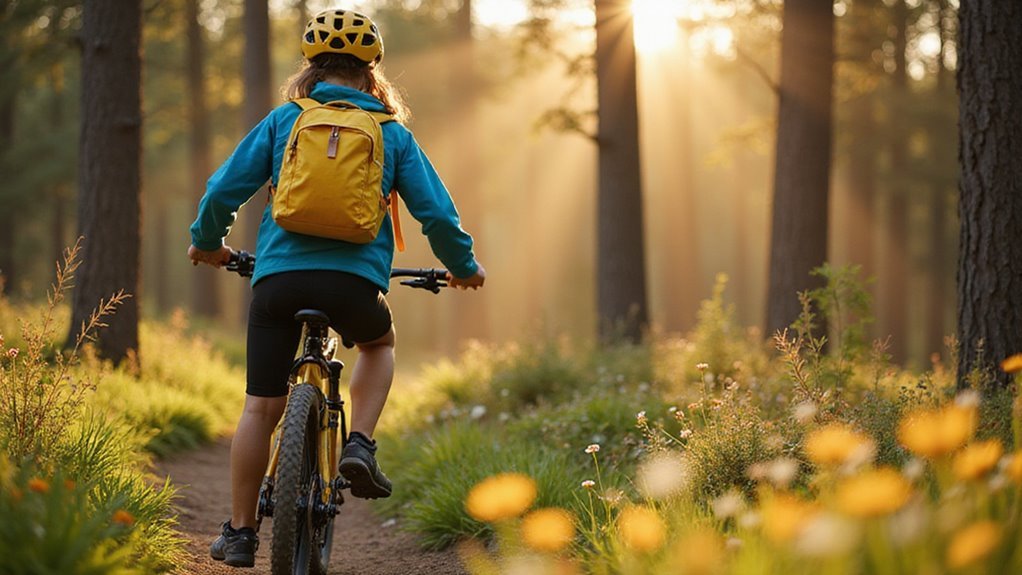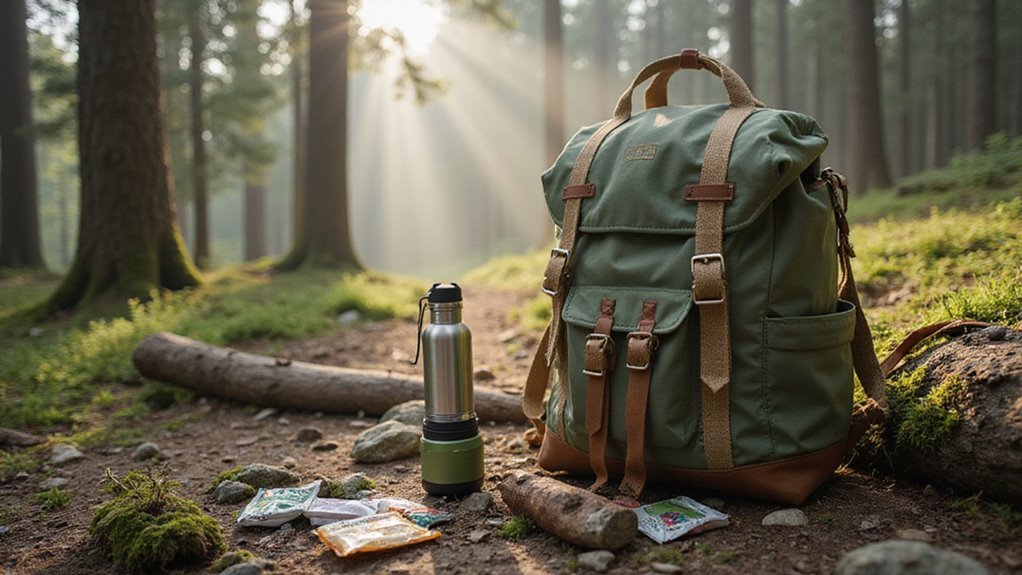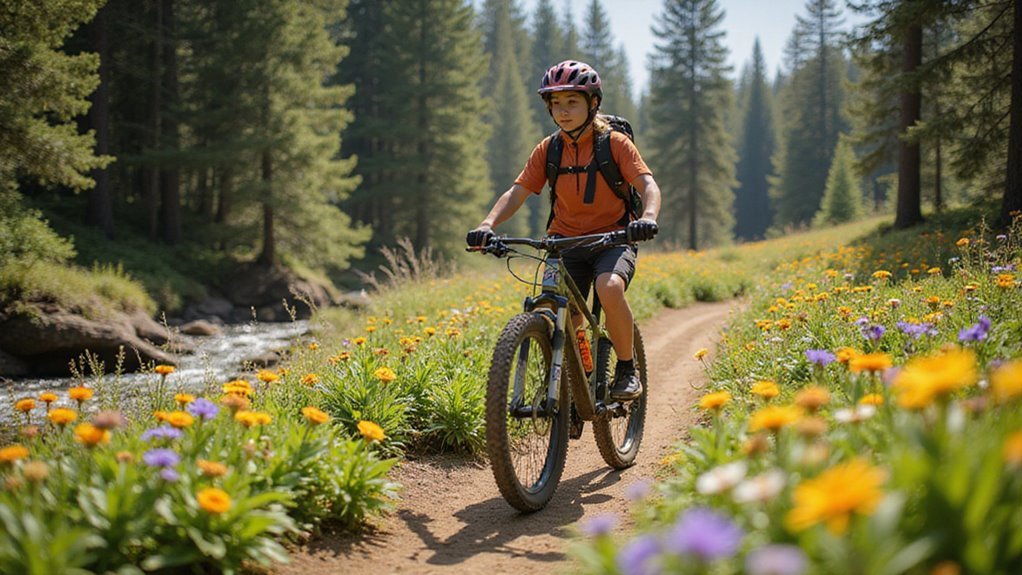We’ve got to talk about green gear on trails – it’s not just another eco-trend. Every piece of sustainable equipment we choose impacts the environments we love to explore. From recycled materials to responsible manufacturing, our gear decisions ripple through entire ecosystems. Sure, traditional options might be cheaper upfront, but they’re costing us more than money. Let’s examine why switching to sustainable trail gear isn’t just smart – it’s essential for our outdoor future.
Sustainable Materials Revolutionizing Trail Gear

While traditional outdoor gear has long relied on environmentally taxing materials, we’re witnessing a seismic shift in trail gear manufacturing.
Sustainable materials are redefining our outdoor gear choices. We’re seeing recycled polyester slash energy consumption by 59% compared to virgin materials, while organic cotton cuts water usage by a staggering 91%.
Here’s the kicker – hemp outperforms traditional fibers by producing 250% more material per acre. Eco-friendly certifications like GOTS and Bluesign® are your guarantee that your gear meets strict eco-standards.
The future of trail gear? It’s green.
Environmental Benefits of Eco-Conscious Backpacks
Because today’s eco-conscious backpacks pack a serious environmental punch, they’re revolutionizing how we gear up for the trail.
When we choose sustainable gear, we’re making a significant impact on our planet’s health.
Here’s how these packs deliver:
- Recycled materials slash virgin resource demand and carbon footprint.
- Bluesign-certified manufacturing guarantees environmentally responsible production.
- Durable construction reduces replacement frequency and waste.
- Natural, biodegradable materials prevent harmful microplastic pollution. Additionally, brands like Patagonia’s Worn Wear Program promote repair and recycling over replacement, fostering a culture of sustainability.
Top Green Features to Look for in Hiking Equipment

Now that we’ve covered eco-conscious backpacks, let’s zero in on the exact features that separate genuinely sustainable hiking gear from greenwashed imposters.
When shopping for durable gear, look for 100% recycled materials – they’re non-negotiable. Your waterproof jacket should sport eco-friendly DWR treatments, and everything needs bluesign certification.
We’re not messing around with pseudo-green claims here. Real sustainable equipment comes with lifetime warranties and repair options. It’s that simple.
Skip anything that can’t be fixed or maintained. Remember: truly eco-friendly gear isn’t just about materials – it’s about longevity. Buy once, repair often, waste nothing. Additionally, consider gear made from recycled materials to further reduce your environmental impact.
Cost-Effective Ways to Switch to Earth-Friendly Gear
Making the switch to eco-friendly hiking gear doesn’t require emptying your bank account. We can embrace sustainable hiking through smart choices that benefit both our wallets and the planet.
- Scout second-hand gear from reputable outdoor retailers – quality items often have years of life left.
- Invest in durable gear with lifetime warranties – it’s cheaper than replacing cheap equipment annually.
- Learn basic repair skills to extend your old gear’s lifespan – fix don’t replace.
- Make your own trail snacks in reusable containers – slash costs while reducing packaging waste.
Additionally, regularly check zippers and hardware to ensure your gear remains functional and durable for longer periods.
These strategies make eco-friendly hiking accessible while building a sustainable outdoor community.
Long-Term Impact of Choosing Sustainable Outdoor Gear

When we select sustainable outdoor gear, our choices ripple far beyond the immediate purchase.
By choosing gear made with recycled materials and durable materials, we’re slashing carbon emissions and keeping mountains of textile waste out of landfills.
Our sustainable gear investments drive industry-wide transformation.
Every eco-conscious purchase signals manufacturers to adopt cleaner practices.
Plus, these items last longer – meaning fewer replacements and less resource drain over time.
We’re not just buying better equipment; we’re voting for Earth’s future.
The outdoor industry’s 10% chunk of global emissions shrinks with each sustainable choice we make.
Frequently Asked Questions
Should I Wear Bright Colors When Hiking?
As bright as a beacon in the night, we recommend wearing vibrant colors while hiking. It’s a smart choice for hiking safety and visibility concerns, plus trail etiquette suggests making ourselves easily noticeable.
Are Trails Good for the Environment?
When we maintain sustainable trails and follow eco-friendly practices, they’re beneficial for nature. They help minimize trail impact, support wildlife conservation, and increase environmental awareness while protecting delicate ecosystems.
Why Do People Go on Trails?
We hit the trails for multiple reasons: to gain fitness benefits, connect with nature, find stress relief, pursue adventure exploration, and experience community bonding with fellow hikers along the way.
What Is the Meaning of Trekking Trails?
We’ll find trekking trails are designed paths for nature exploration and hiking benefits, combining trekking basics with trail safety measures to help us safely navigate diverse terrains and outdoor environments.